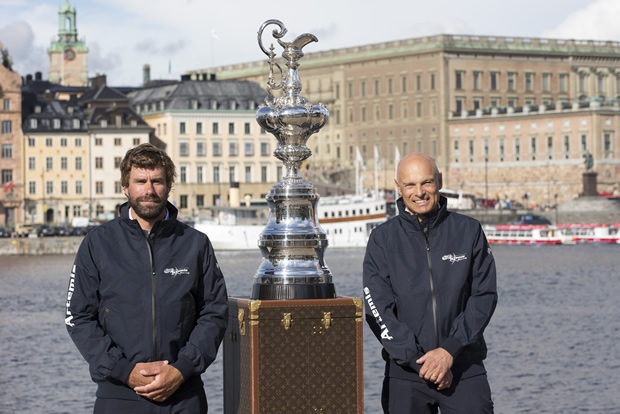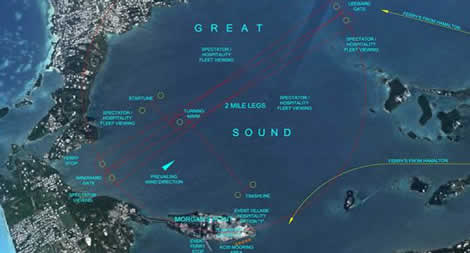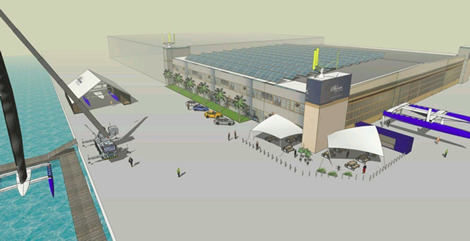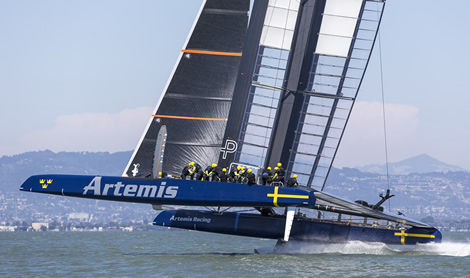
America's Cupdate with Iain Percy
Torbjörn Törnqvist’s Artemis Racing team is in Stockholm en masse today for the official presentation of its challenge for the 35th America’s Cup. The Swedish team formally entered the next competition via the Kungliga Svenska Segel Sällskapet (the Royal Swedish Yacht Club) before the deadline of 8th August and has since had its challenge accepted by the Golden Gate Yacht Club (aka Oracle Team USA).
With the Oatley family’s Hamilton Island Yacht Club pulling the plug on its campaign, the task of Challenger of Record, according to the Protocol for the 35th AC, goes to the next yacht club to challenge. While it hasn’t been announced, Luna Rossa is believed to have inherited this job of negotiating the nuts and bolts of the next event with the defender, a task viewed by many challengers as a distraction from the main objective: Winning the America’s Cup.
As Iain Percy, Artemis Racing’s Team Manager, puts it: “We weren’t the last to enter, but we weren’t the first either – we made a point of that!”
Aside from launching the Swedish team’s challenge, a key message today is that Artemis Racing is single-mindedly entering the 35th America’s Cup with one goal. “All the choices we’ve made - from the designers that we’ve poached from Oracle and Team New Zealand, to the amount of talent on the sailing team, we are only in this for one reason and that’s to win,” states Percy.
Other secondary goals of the campaign have also been announced today such as sustainability. “We are a major sports team and it is our responsibility to promote doing things in the right way. We don’t want to be trashing massive bits of carbon or leaving old buildings to rot,” as Percy puts it. In this respect he is motivated by preventing a recurrence of what has happened to the Darsena in Valencia, which seven years after the 32nd America’s Cup, is now simply rotting away, largely disused.
There are no concerns about their existing base in Alameda. This is an old naval aircraft hangar where sea planes used to be made “and now it’s kind of making sea planes again,” as Percy puts it. Their base sits on prime real estate which allegedly Google has first refusal on. Bigger concerns about sustainability are over the team’s new semi-temporary base, to be located in either San Diego or Bermuda, whichever is chosen as the 35th AC venue. Then there is also the no small matter of the team’s unlike-to-ever-be-sailed-again AC72 and how this can be incorporated somehow into that new facility.
In addition to this, Artemis Racing is introducing an ‘intern’ program where four 18-24 year old Swedes, one a girl, will join the team for two months, working in different departments. “They will be there to learn about what an America’s Cup team is and hopefully get impassioned about it for the future,” says Percy.
35th AC
As to the more meaty 35th America’s Cup topics, despite the perennial controversy surrounding this and past events, Percy says his and the team’s approach is to maintain a balanced point of view.
Firstly, despite the wranglings and in-fighting, he is at pains to point out that in the big picture if the final of the 34th America’s Cup is any gauge, then the 35th promises to be an even better sports event. “It is going to be fast, foiling cats, close exciting racing, a format of racing that we think works with the reaching starts – some of the stuff that really worked is being built on and that is the overriding message
“Torbjörn [Törnqvist] says he feels really privileged to be part of this new wave of sailing, where the sport for the first time is being taken to an audience outside of the traditional sailing fans. It is hard sometimes if you’re involved, but I’ve heard from people who aren’t sailors that it [the 34th AC] was the most spectacular sporting product to watch. It has more visual ‘wow’ factor than Formula 1, it has the tactics and technology of F1 with a huge billboard and impressive scenery. Sailing for the first time is being showcased in this fantastic way and that is something that Oracle clearly wants to continue and that we support.”
Following the loss of Andrew Simpson, safety is obviously a paramount concern for Artemis Racing and Percy is satisfied that while the specifics of this have yet to be finalised for the 35th America’s Cup, the will is there to improve this. “We are all working to keep that at the forefront. As a team we have shared any incidents we’ve had on the water with the other teams and trying to compile a report, almost like the aircraft industry would to keep an open understanding of things that can affect safety.”
As to costs involved with the next America’s Cup, Percy feels that there have been attempts made to keep them down or at least to prevent them escalating beyond where they were for the 34th. However the significant difference this time is that many more of the costs associated with the event, and traditionally picked up by the Defender, have this time been passed over to the Challengers.
“Our position is that we understand the great investment that Larry [Ellison] and Oracle have made into our sport and we are very grateful for that. And we understand that can’t be something that continues forever. I look at it like this: because of the great success of the [34th AC] final, the event now is something that could well be a profitable, sellable product. That profit is going to fall on Oracle, the holder of the Cup, this time around, but it is our job is to make sure we are the holder of the Cup next time, to take benefit of this fantastic product. Let’s not forget last time that investment was made by those same people who invested a lot more, I’m sure, than they will recoup this time.”
Percy adds that he sincerely hopes that the 35th America’s Cup is more profitable than the last event and can be better exploited, because there is no great incentive in winning the event if staging it successfully the next time comes with an astronomic price tag attached.
However he also worries whether the drive to make the 35th AC more profitable might end up compromising the event itself. “One of the major points we have concerns over is that the commercial pressures to reduce costs/make money for the event itself don’t compromise the quality of the racing. Although that might be a short term gain, it could be a long term cost. What we need is another fantastic event, with a great final and great racing up to the final, with more teams that are on the pace and that is on the cards with this second generation technology.
“What we have concerns about is that we go back to a world where we miss three days of racing on the trot because there’s no wind and the things that have cursed a TV audience in our sport in the past. We don’t want to lose the TV audience that came back in their millions for the last event.”
This is particularly relevant to the choice of venue. Regardless of the type of boat, racing in strong winds, where each crew is at the limit of its physical ability and control of its vessels, is much more exciting than racing in light winds. This is especially true of a sport still attempting to develop its TV following. It is also vital when foiling cats are the race boats, where if the wind speed is sub-8 knots it is probably faster to race boats that don’t foil.
So San Diego for example – daily average wind speed through the summer is 7 knots, its daily average maximum 11 knots. Bermuda – daily average wind speed through the summer 11-12 knots. San Francisco – daily average wind speed through summer 11-12 knots, its daily average maximum 22 knots.
“In terms of its weather and its geography there are few who would debate that San Francisco was the perfect venue,” continues Percy. “Our studies of the venues are very preliminary but none of them beat San Francisco for the consistency of the breeze, although not many places in the world do... San Diego is lighter, but maybe consistent enough, whereas Bermuda will be inconsistent but with some great days. If its Bermuda they’ll hold it in the Great Sound which in fact is the best area of them all - it has a good four mile circle right there between tropical islands. It has got the potential to be great to watch, but probably only on TV because of the accessibility issues. There are more vantage points there, than places to stay!”

Two venues
For those that haven’t been completely following developments with this America’s Cup, one of the substantial changes to the racing format is that the Challenger Selection Series/Louis Vuitton Cup is now to be split in two. Part one will be the ‘America’s Cup Qualifiers’, which will be open to all the challengers, but controversially the defender will compete in this and it will be held in a different location to the Cup venue itself. Only the top four Challengers (rather than all of them) will then go through to the America’s Cup Challenger Playoffs (all very NFL…) to be held at the Cup venue, the winner of which will then get to line up against the defender, Oracle Team USA.
To a man, the duel venue idea with only the top four going through hasn’t gone down well with the Challengers and Percy feels it is wrong this time. “The overriding message is that we are building on a great product, that is more sellable for us to sponsors, with new visions, etc, but we don’t see the need of going to a second venue.”
Firstly there is the ‘fairness’ issue. Effectively the challengers must be competitive in two venues, whereas the defender needs only to prepare for one. “The challengers need to perform there whereas the defender doesn’t ultimately,” says Percy. “And however much you say ‘we’ll try and keep the venues similar’, they are going to have slightly different wind.”
Percy also compares the scenario to the dilemma of the British 49er squad, which is traditionally quite large and its sailors can end up finding themselves gunning harder to win the trials than the Olympic Games themselves.
Aside from this, Percy also feels that everybody not being able to race at the main AC venue will put off fledgling teams. That is not just down to the additional cost of racing in two venues. “For me at this stage personally, the priority is growing the sport and not discouraging new entries.
“Last time it was really tough for us, but for me and for a lot of people within our team, being able to watch that great Final and feeling part of it in San Francisco was something that was very special and it still feels special. It was a great sporting event to feel we were part of. I would hate to think of a new team which was considering challenging thinking ‘we might not make it to the event’. That is hardly an encouragement to entry.”
As to Oracle Team USA being able to compete in the America’s Cup Qualifiers – remember that a challenger giving the defender the benefit of allowing them to race or train with them was considered completely unthinkable up until only a few years ago – Percy confirms that it has taken away one of the traditional disadvantages of the defender, even if it is only in part of the challenger selection series.
Percy isn’t overly concerned about the Defender being able to build two boats to each challenger’s one as the advantage of this has been kept to the absolutely minimum.
“I can see from the defender’s point of view that with these races get shorter and the series getting shorter to fit it into a TV product, you could get caught on the hop if it [the America’s Cup match] was the first time you’d ever sailed. That is why they wanted to mitigate it both by racing in the series and then not being left on their own without training before the event. That has to be recognised and we are not up in arms about it - we are just going out there to win with the rules as they are.”
Saying this, with the Challenge of Record now departed, the interaction between the challengers and defender has changed recently and according to Percy the challengers (including Emirates Team New Zealand) and the defender are talking every week at present. “Everyone has their own position, but at least it is being openly talked about and to the surprise of a few people we all tend to have similar views on a lot of things…”
One agenda point is obviously finding a way to get rid of the second venue for the America’s Cup Qualifiers. One reason for the second venue is its fiscal benefit, so a solution needs to be found to overcome that. “It is an admirable goal that they are trying to make a sustainable model so the event at least pays for itself and part of that was the dual venue concept, but the overall loss is a net negative to the total money being spent,” states Percy.
There is the view that with Team Australia out and there now being four Challengers that the second venue being thrown out will become a self-fulfilling prophecy. However it is believed that more Challengers, in addition to the remaining four, may have or may be about to enter, something we shall no doubt hear more about in the coming weeks.
We'll publish part 2 of this interview tomorrow










Latest Comments
Add a comment - Members log in